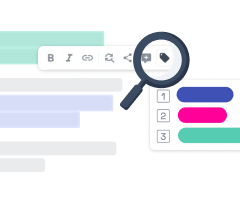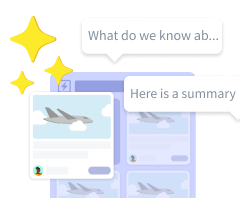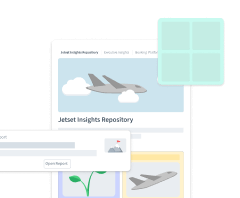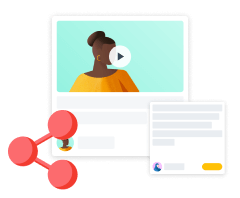
How to work with Condens Artifacts
Artifacts are one of the most important parts of Condens - they play a crucial role in structuring and presenting engaging research outcomes to your colleagues. Using the Artifacts in your research workflow can be beneficial for many reasons. It gives you the opportunity to integrate raw data — such as video clips and audio recordings — into the final reports, which can significantly enhance your audience’s engagement. They can also be easily shared via public links or within the dedicated stakeholder repository, which improves the discoverability and accessibility of valuable research insights.
Condens Artifacts come in two formats: documents and whiteboards. This allows you to use them in different ways and stages of your research, whether it’s:
Initial analysis: to write down your first notes and observations while analyzing your raw data
Affinity Mapping: to discover underlying patterns, either on your own or together with your colleagues
Atomic Research: to create and compile a collection of findings that let you delve deeper into a specific topic
Research summary: to summarise your findings and observations and make it easy to share with the rest of your organization
Collaborative workshops: to engage colleagues and stakeholders in collaborative workshops to foster collectively generated insights.
Insights presentation: to present research outcomes to your team or stakeholders in a structured and visually appealing format

When working with Artifacts, it’s important to prioritize their intended purpose. For example, if you’re crafting a report for stakeholders, start by identifying the information most relevant to them and consider whether a streamlined and minimalistic report would be enough, or if a more detailed and visual presentation could capture their attention better. Adjusting the type and format of Artifacts to suit your audience will help maximize the impact of your research.

While no universal Artifact format can fit every organization or team, Condens provides a set of templates commonly used in UX Research that can spark your creativity and help you get started. And if there’s already a format you and your team are familiar with, you can easily recreate it in Condens.
Interview Snapshots for Analysis
When analyzing your research interviews in Condens, you probably find yourself taking notes on the side, using our split-screen mode. If you would like to organize and extract important information in a more structured way, consider implementing an Interview Snapshot into your workflow. Introduced by Teresa Torres, this framework enables you to capture the most significant aspects of your interview session in a more compact format. An Interview Snapshot typically includes:
A photo of the interviewee: Including a picture of the participant or a Condens avatar helps personalize the insights collected from the interview.
Quick participant facts: In this section, you can provide brief information about the interviewee, such as demographic or background details, to provide context for the insights shared.
A memorable quote from the interview: Highlighting a standout quote that captures the essence of the interview adds depth to your Snapshot.
Insights: This section provides a summary of the most important information extracted from the interview.
Opportunities: Here, you can identify areas for improvement or further exploration based on the interview findings, which will then guide future research direction.
Interview Snapshots can be created as Note-based artifacts or on a whiteboard. Not only do they allow you to focus on the essential elements of your interview, but they also serve as a perfect format for sharing insights with colleagues and stakeholders without overwhelming them with excessive detail.

Collaborating on Artifacts
Condens is a fully collaborative tool, and Artifacts provide an ideal space for teamwork. You can invite fellow researchers to develop a User Journey Map together or organize affinity mapping sessions with designers. These sessions allow you to collectively categorize and group user feedback, observations, and insights from research activities like interviews or usability tests.

As a part of Condens Business and Enterprise plan, you also have the opportunity to invite Full-access Stakeholders to participate in collaborative workshops. This approach fosters stakeholder engagement in earlier stages of the research process, providing them with deeper insights into your work. The workshops can be organized inside any Artifact, whether it involves clustering raw data on a whiteboard or collectively discussing and formulating findings in a final report.
For example, if you're planning to collaborate with a group of stakeholders on a Condens whiteboard, consider organizing a watch-party for them. Before the workshop, gather a collection of video highlights you'd like them to view and place them on a whiteboard. During the workshop session, participants can watch the videos together and contribute their insights through comments and discussions. This interactive approach encourages stakeholder engagement and enables collaborative understanding.
Atomic Research
Artifacts are designed to be used in a modular way and therefore are perfect for implementing Atomic Research. In Condens, Atomic Research starts by creating Highlights from your raw data, which act as pieces of evidence. You can then proceed to group your Highlights into smaller, singular Finding Artifacts, using either existing templates or ones you create yourself. Finally, compile your findings into a complete report by simply dragging them inside. Artifacts and Highlights can be linked across multiple reports and thereby applied in various contexts. This approach releases findings from being tied to one report only and also makes them discoverable individually via the search.
Providing recommendations & linking related research
Many teams include recommendations in their reports, so ensuring they reach the right audience is essential. If your reports tend to be rather lengthy, consider adjusting how you present your recommendations. Rather than listing them all at the end, include a recommendation after each finding throughout the report, while still including the summary at the conclusion. Using different heading sizes for recommendations allows stakeholders to locate them easily within the report outline, simplifying navigation based on their needs.
Additionally, consider leaving space for related research at the bottom of your reports in Condens. An easy way to do this is by embedding other Artifacts, such as relevant whiteboards or smaller findings, directly into your report. This approach allows your stakeholders to discover related research and helps to build a more complete understanding.

Presenting your Artifacts
Making your findings engaging and relevant to stakeholders is key to driving impact. Instead of overwhelming them with extensive reports, Condens helps you present insights in a way that’s easy to navigate and compelling to explore.
With the Insights Magazine—the dedicated stakeholder repository—you can structure findings in a way that’s clear, relevant, and engaging for different audiences. Instead of a one-size-fits-all report, you can create tailored content—concise summaries for executives who need quick takeaways, and in-depth reports for product and design teams looking for detailed insights.

To make insights even more accessible, Condens offers conversational AI-powered search, allowing stakeholders to quickly get relevant answers without having to sift through lengthy reports. Whether they’re looking for past research on a specific topic or need a quick refresher, AI search ensures they can access the right insights, fast.
Additionally, you can set up multiple Magazines to organize findings for different teams, initiatives, or business units. This keeps insights focused and ensures that each group gets the most relevant research in a format that resonates with them.
By structuring findings in a way that aligns with your audience’s needs—and making it easy to explore them—you ensure that research is not just shared, but actually used.

Before creating your reports, always keep your audience in mind to ensure that the information included is relevant and actionable for them. This strategy makes your communication more effective and fosters better engagement and understanding among different groups of stakeholders.




